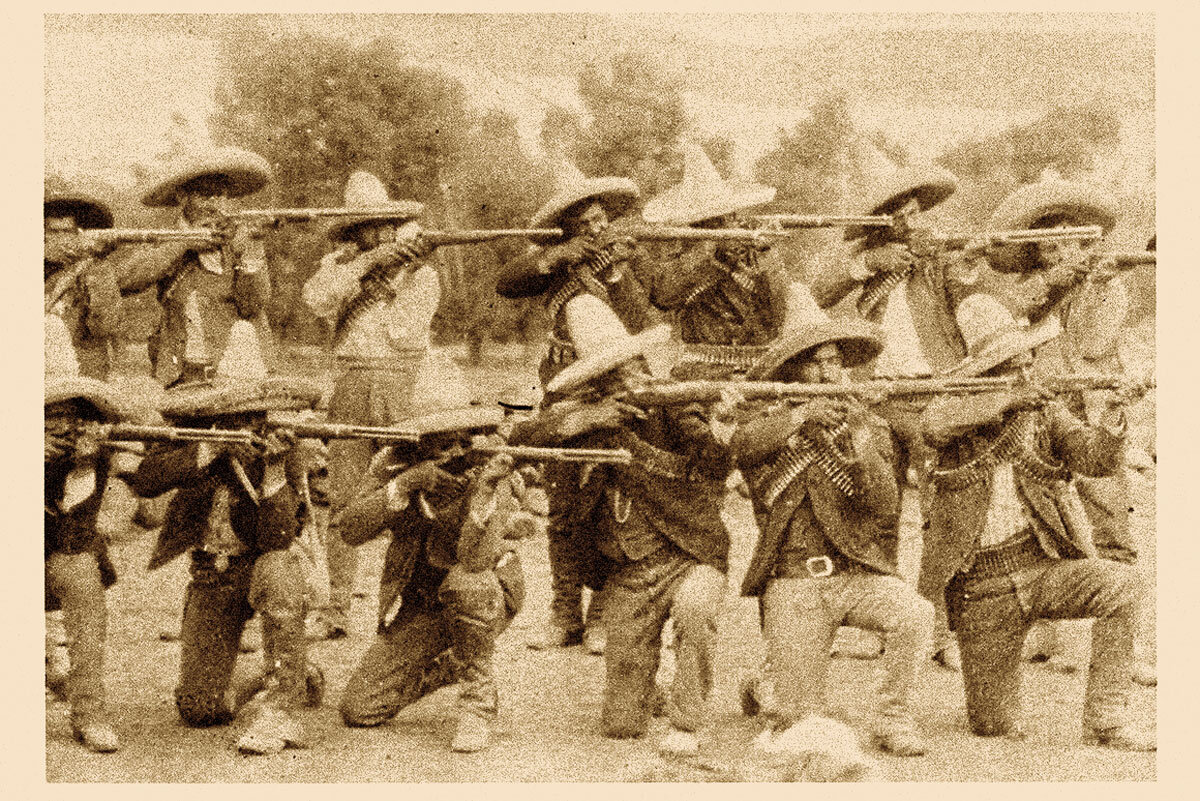Timeline of the Mexican Revolution
1910
May 1910 – Halley’s Comet looms over the skies. Many in Mexico view it as a bad omen.
June 1910 – Mexico holds elections and President Porfirio Díaz declares himself president for a seventh term. He has his opponent, Francisco Madero, arrested.
August 1910 – Tensions rise as mining strikes occur and small uprisings are crushed.
September 1910 – Mexico celebrates its 100th Anniversary of Independence, as well as President Porfirio Díaz’s 80th birthday with elegant balls and parades.
October 1910 – Madero flees to San Antonio, Texas where he drafts his “Plan of San Luis Potosí”, declaring President Díaz’s re-election fraudulent and urging Mexicans to take up arms against him.
November 20, 1910 – According to the “Plan of San Luis Potosí”, this day at 1800 hours is the official start of the Mexican Revolution.
December 1910 – Miners, ranchers, peasants, schoolteachers, lawyers, merchants and women join the revolution.
1911
April 1911 – The revolution becomes more organized as battles are won against federal forces and more regions are being controlled by the Revolucionarios, the rebels.
May 1911 – The leader of the northern rebel forces, General Francisco “Pancho” Villa, wins a major battle at Ciudad Juárez, and after thirty-one years of dictatorship, President Díaz steps down. He is quickly exiled to France.
November 1911 – Francisco Madero is elected president, taking 90% of the votes, and the leader of the revolutionary forces in southern Mexico, Emiliano Zapata, writes the “Plan of Ayala”, demanding land reform.
1912
March 1912 – Two powerful families in Mexico fear President Madero will implement land reform. They supply money and weapons to Pascual Orozco, a onetime ally of Pancho Villa, and promise him political power in return for fighting against Madero.
April 1912 – To put down Orozco’s rebellion, President Madero turns to a former general of the Díaz regime, General Victoriano Huerta.
October 1912 – General Huerta defeats Orozco’s rebellion, but a new rebellion, led by Porfirio Díaz’s nephew, Félix Díaz, emerges.
1913
February 1913 – General Huerta and Félix Díaz secretly negotiate a coup against President Madero, and with the “blessing” of U.S. Ambassador Henry Lane Wilson, Madero is arrested. Three days later, Madero, his brother, and his vice president are executed.
March 1913 – After General Huerta takes office, he ships Félix Díaz to Japan, silences the press, jails 110 members of congress, and has over one hundred of Madero’s supporters shot. In the U.S., President Woodrow Wilson takes the oath of office.
April 1913 – General Huerta and his Federales fight Pancho Villa and Venustiano Carranza in northern Mexico and Emiliano Zapata in the south.
September 27, 1913 – Over 3,000 refugees head north towards the border town of Piedras Negras, Coahuila following raids, forced conscriptions and destruction of the region’s towns and villages.
September 28, 1913 – A regiment of 1,600 Federales heads to Piedras Negras to control the northern border.
September 30, 1913 – U.S. Cavalry and Field Artillery soldiers and a hospital unit from Fort Sam Houston in San Antonio are ordered to the border town of Eagle Pass, Texas.
October 2, 1913* – A storm system develops in the area, bringing floods to central Texas and heavy down pours at the border. After cases of smallpox are detected, 200 refugees who had crossed into the U.S. are returned to Mexico.
October 3, 1913* – A head tax of $5 is imposed for Mexicans wanting to cross into the U.S. As rebels begin to leave Piedras Negras, they destroy bridges and mines.
October 4, 1913* – A band of women soldiers, belonging to the advanced guard of the Federales, rides through the outskirts of Piedras Negras. They announce the approach of the Federal regiment and threaten people with death if they join the rebels or attempt to cross into the U.S.
October 5, 1913* – Colonel Francisco Sánchez Herrera of the revolutionary forces assembles the refugees in the town square of Piedras Negras and pleads with them to remain loyal to the rebel cause and promises that Federal rule will be short lived.
October 6, 1913* (in the twilight hours) – The last of the remaining rebels leave the military barracks at Piedras Negras.
October 6, 1913* – The Federales arrive at the hilltops of Piedras Negras and over 6,000 refugees flock to the international bridge. As Federal cavalry troops rush towards the border, U.S. Army soldiers open the bridge.
* May have occurred the day before or after. Different newspaper sources and books report the events happening on different days. The discrepancies may be due to the remote location of the border and the ongoing conflict in Mexico.

